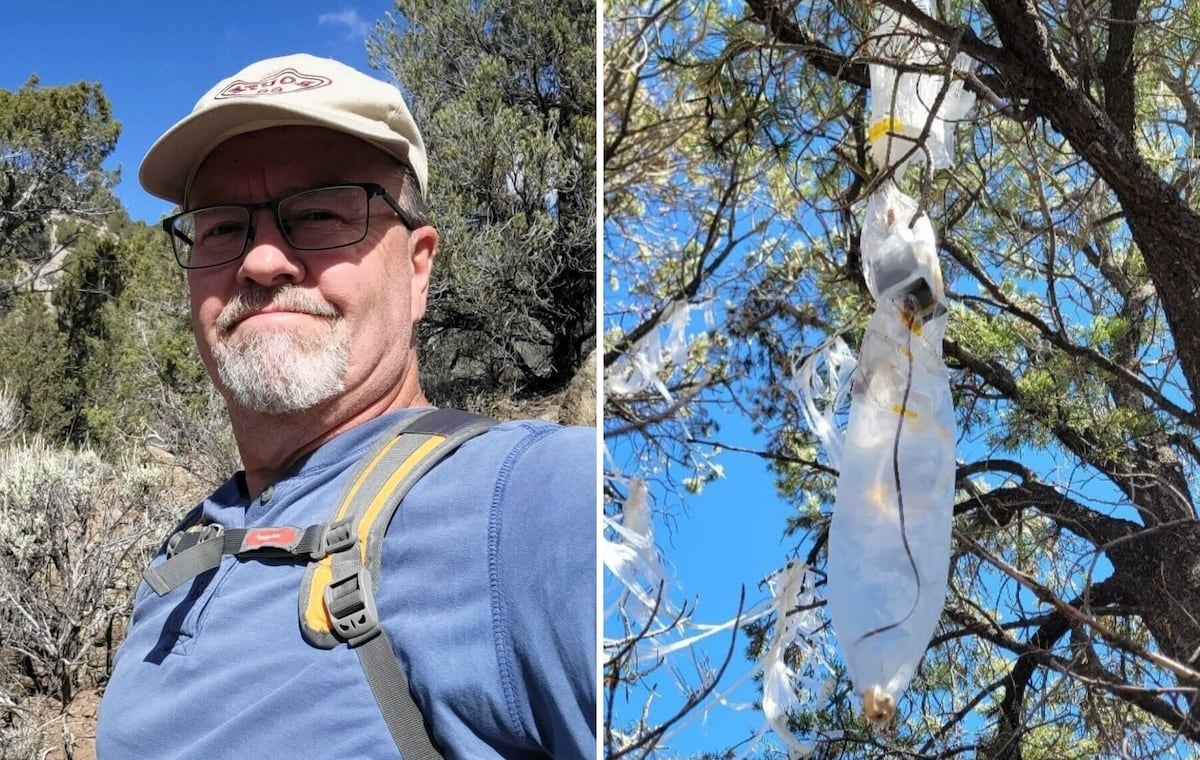Ranse Parker — like many Utahns — loves a big trip into the mountains and deserts of the West.
But he’s not usually after a great hike or a big buck. Instead, he’s hunting for fallen weather balloons launched by the National Weather Service, military installations and private companies.
Armed with two tracking stations, one at his home in Layton and a portable version, Parker picks up radio signals from the balloons and then goes to find them once they’ve fallen back to Earth. He also pays attention to tracking data published by others — including a dozen additional Utah hobbyists who’ve built their own stations from Logan to St. George.
On Sunday night, as he was doing his usual rounds of scouring data, he noticed something peculiar on a webpage for WindBorne Systems, a private weather balloon company. One balloon had “landed” near Moab at a head-scratching 36,000 feet.
Then he started putting the pieces together.
Parker knew of United Airlines Flight 1093 having to divert to Salt Lake City after cracking its windshield over the Utah desert on a route from Denver to Los Angeles. He knew the speculation taking over social media was that the plane struck “space debris,” even if he thought such a theory was “silly.” He knew whatever happened was a mystery to most.
A-ha.
Connecting the dots
The time of the balloon’s last transmission was early in the morning on Oct. 16, the same time that United 1093 was near Moab, according to data from airplane tracker FlightAware. The altitude where it last sent a signal, meanwhile, is where passenger jets typically fly.
“I was surprised that apparently nobody else had figured this out yet,” Parker said. “… Even though I had suspected it was probably a weather balloon, I hadn’t really thought about whose it might have been until I happened to connect the dots.”
The National Transportation Safety Board said it was investigating the collision but has not confirmed the jet hit the balloon apparatus — likely, Parker said, a bag of sand that acts as ballast for WindBorne’s transmitter systems.
United’s Boeing 737 Max 8 was carrying 134 passengers and six crew members when it was diverted. It landed at the airport at 7:37 a.m., leaving passengers to take another flight to Los Angeles later in the day.
When reached for comment, United provided no new information. The NTSB and the Federal Aviation Administration did not respond to requests for more information.
After discovering the evidence, Parker posted what he found on a private Facebook group of weather balloon hobbyists called Radiosonde North America, which he started in 2021. WindBorne’s head of communications, Ellie Yoon, is a part of the group, Parker said. Later, he said, she messaged him that the company’s operations team had been notified of the situation involving the flight and that the firm was in the process of communicating with the FAA. Then, she requested that Parker remove the post so the company could investigate officially, he said.
The next day, the company removed the balloon’s landing location from its website, Parker said. That night, WindBorne CEO John Dean wrote on the social media platform X that the company had learned of the possible collision between the jet and the balloon on Sunday night and that he thought the damage to the plane was caused by one of the firm’s devices.
WindBorne did not respond to questions about Parker’s account.
‘Extremely concerning, and unacceptable’
WindBorne, a California company, launches weather balloons that stay up in the atmosphere for weeks. The company pairs observations from those long-duration balloon journeys with artificial intelligence predictive models to make forecasts. Weather service balloons, on the other hand, only hang in the air for hours. WindBorne can also control the height of its balloons to get different atmospheric readings.
The firm’s balloons carry a payload of about 2.4 pounds at launch, consisting of a bag of sand, a solar panel, wiring and a transmitter — it comes out to about 13 times heavier than the weather service’s balloons. The WindBorne systems get lighter as they fly, dropping sand and releasing air to control altitude.
“The system is designed to not pose a risk to human life in the worst-case event of a collision,” Dean wrote on X. “This is what [federal] and [international] weight limits are for. And indeed, there were no serious injuries and no depressurization event, to my knowledge, as a result of the collision.”
The firm said it complies with all federal regulations around weather balloon flights, often issues notices to pilots about balloons, coordinates launches with air traffic control and shares the locations of its airborne systems with the FAA. The federal agency’s Aeronautical Information Manual instructs pilots to steer clear of such balloons, refrain from flying under them and report any they see to the nearest air traffic control.
It was not immediately clear how often planes collide with weather balloons.
“I find this extremely concerning, and unacceptable in the case of a collision, regardless of what the official regulations are,” Dean wrote on X. “It resulted in injury to a pilot, which I’m simply not okay with whatsoever.”
The NTSB does note at least one minor injury in its listing of the accident but lists no further information. Unconfirmed photos plastered across social media seemed to show cuts and bruising on a pilot’s arm.
Improving safety
In a blog post on WindBorne’s website, the firm said it had updated its software in response to the collision so that balloons would spend less time between 30,000 and 40,000 feet. The company also indicated it would pursue further changes to its software that would allow balloons to autonomously steer clear of flight paths using live data, and that it would investigate alterations to the payload that could reduce damage when collisions occur.
Parker, who is a former tech business owner and engineer by trade, first got interested in weather balloons as a kid in southern Idaho when he stumbled across an electronic box in the middle of the desert. However, it wasn’t until 2018 that he turned balloon chasing into a hobby, after he saw one floating above Centerville.
The hobby has taken him all across the West. He’s found one launched by officials at Area 51 in the eastern Nevada mountains and another near the top of Francis Peak near Farmington. On a vacation to Hawaii’s Big Island in February, he located a balloon, one of only two recorded recoveries ever there.
Now, he may be able to add solving an aviation mystery to his list of accomplishments.
Note to readers • This story is available to Salt Lake Tribune subscribers only. Thank you for supporting local journalism.
First Appeared on
Source link













